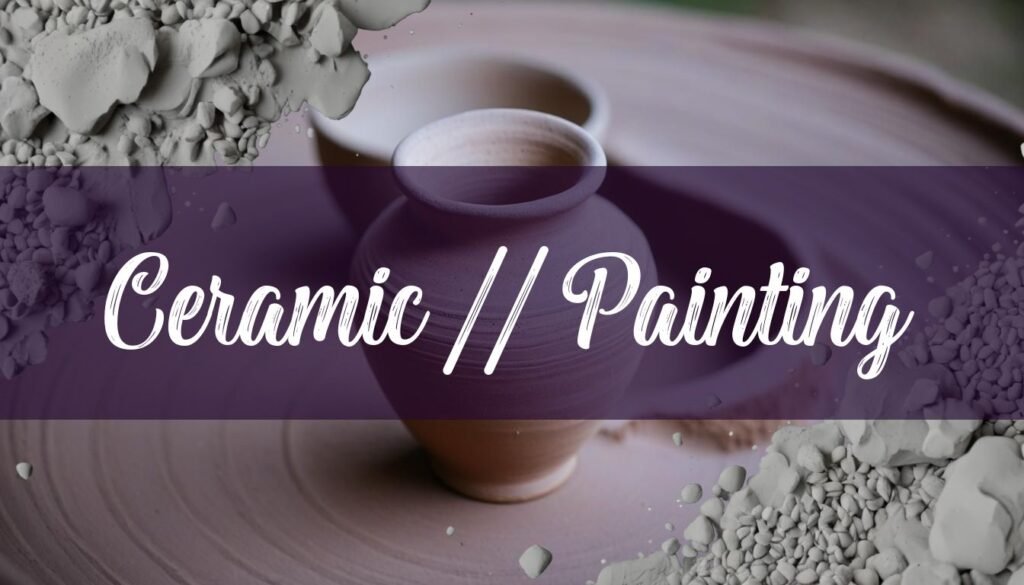Ceramic painting is the art of applying paint to ceramic surfaces, transforming functional objects and artistic pieces into vibrant expressions of creativity. It’s a versatile craft that distinguishes itself from other ceramic art forms like pottery (the creation of ceramic objects) and sculpting (shaping clay into three-dimensional forms) by focusing specifically on surface decoration. Ceramic painting allows for intricate designs, colorful imagery, and personalized touches that elevate the ceramic piece to a unique work of art. The beauty of ceramic painting lies not only in the finished product but also in the process, offering a tactile and engaging experience for artists of all skill levels.
A Journey Through Time: The History of Ceramic Painting
The history of ceramic painting stretches back millennia, with evidence found across various cultures and civilizations. Ancient Greek pottery, for example, is renowned for its black-figure and red-figure techniques, where intricate scenes from mythology and daily life were painted onto vases and amphorae. These early examples demonstrate a sophisticated understanding of ceramic materials and painting techniques, using slip (liquid clay) to create detailed silhouettes and narrative compositions.
Moving forward in time, the vibrant traditions of Majolica painting emerged in Renaissance Italy. Majolica ware, characterized by its tin-glazed surface, provided a blank canvas for artists to create colorful and elaborate designs. The technique involved painting directly onto the unfired glaze, allowing the colors to fuse with the glaze during firing, resulting in a durable and lustrous finish.
Across continents, Chinese porcelain painters developed exquisite styles of decoration, particularly during the Ming and Qing dynasties. Using overglaze enamels, they produced intricate floral patterns, landscapes, and figural scenes on porcelain wares, showcasing exceptional skill and artistic finesse. You can further explore the history of the medium through traditions like Southwestern Pottery, which has its own unique story.
These historical movements demonstrate the diverse approaches to ceramic painting, each reflecting the unique cultural and artistic values of its time. Today, ceramic painting continues to evolve, blending traditional techniques with contemporary aesthetics and technologies.
Unlocking Creativity: Techniques in Ceramic Painting
Ceramic painting encompasses a range of techniques, each offering unique effects and artistic possibilities. Slip trailing involves applying liquid clay (slip) onto the ceramic surface using a fine-tipped applicator, creating raised lines and intricate designs. This technique is ideal for adding texture and dimension to your pieces. Underglaze decoration involves painting directly onto bisque-fired ceramics with underglazes, which are specifically formulated to withstand high firing temperatures. Underglazes offer a wide range of colors and can be layered and blended to create stunning effects.
Overglaze decoration, on the other hand, is applied on top of a fired glaze surface. Overglazes typically include enamels and lusters, which are fired at lower temperatures to create vibrant colors and metallic accents. This technique allows for detailed surface embellishments and personalized touches. Majolica painting, as mentioned earlier, involves painting on a tin-glazed surface with specialized Majolica colors. The colors are absorbed into the glaze during firing, creating a bright and durable finish. If you are working with lusters, you might also be interested in Luster Glazes, to add a unique sheen to your work.
Each technique requires specific materials, tools, and processes. Slip trailing, for instance, utilizes slip, applicators, and steady hands to create precise designs. Underglaze and overglaze decoration involve brushes, palettes, and a kiln for firing. Majolica painting requires tin-glazed ware, Majolica colors, and specialized firing schedules. By exploring these different techniques, ceramic artists can expand their creative repertoire and achieve a wide range of artistic expressions.
Choosing Your Palette: Types of Paints for Ceramics
Selecting the right type of paint is crucial for successful ceramic painting. Underglazes are designed to be applied to greenware or bisque-fired ceramics and then covered with a clear glaze. They can withstand high firing temperatures, resulting in durable and food-safe surfaces. Overglazes, including enamels and lusters, are applied on top of a fired glaze surface and require a lower firing temperature. They offer vibrant colors and metallic finishes, adding decorative accents to your ceramic pieces.
Acrylic paints are a popular choice for painting bisque ceramics, prized for their versatility, quick drying time, and ease of use. These water-based paints adhere well to the porous surface of ceramics, creating a durable finish that resists cracking and fading. Acrylics offer a range of vibrant colours and can be easily mixed to achieve custom shades. They also work well with various techniques such as layering, blending, and dry brushing. While acrylic paints are excellent for decorative purposes, they are generally not food-safe and are best suited for pieces that will not be used for serving food. To enhance the durability of acrylic painted ceramics, it is essential to seal them with an appropriate clear sealant, making them resistant to moisture, fading, and cracking.
Porcelain paints are an excellent choice for glazed ceramics as they adhere to the surface better than acrylics. Once painted, the design can be fired in a conventional oven to set the paint, resulting in a waterproof and washable finish. Decola is a highly-rated brand for ceramic paint, creating pigment-dense paints specifically designed for ceramics and glass, which offer a vibrant and long-lasting outcome when baked in the oven. Paint pens, with their fine 0.7mm tips, provide great precision for intricate designs on ceramics and work well on various materials.
Each type of paint has its own specific properties, application methods, and firing requirements. Underglazes and overglazes require a kiln for firing, while acrylics and porcelain paints can be heat-set in a conventional oven. Understanding these differences is essential for achieving the desired results and ensuring the longevity of your ceramic artwork.
Getting Started: Practical Tips for Beginners
For beginners eager to explore the world of ceramic painting, there are several practical tips to keep in mind. Begin with proper surface preparation, ensuring that your ceramic piece is clean, dry, and free of any dust or debris. For glazed ceramics, sanding the surface lightly with fine-grit sandpaper can improve paint adhesion. Applying a primer can also help create a smooth and even surface for painting.
When applying paint, use even strokes in the same direction for consistent coverage. Building opacity by layering thin coats of paint, allowing each layer to dry before applying the next, can help saturate colors and bolden your design. For shading, use a small flat-tipped brush and ensure you have enough water in the paintbrush to help it glide along your piece. If you plan on using stencils, use a small flat-tipped brush for the intricate designs, or use strips of painter’s tape to create straight lines or easily shade in sections.
If firing is required, understand the firing process, temperature control, and potential issues that may arise. Curing paint temperatures may vary depending on the oven, so it’s handy to do a test sample first to make sure. Always follow the manufacturer’s instructions for firing temperatures and schedules, and take necessary safety precautions, such as wearing protective gloves and eyewear.
Contemporary Ceramic Painting: Trends and Artists
Contemporary ceramic painting is a dynamic field, with artists pushing the boundaries of traditional techniques and exploring new forms of expression. Modern ceramic painters are incorporating a wide range of styles, from abstract designs and geometric patterns to intricate realism and narrative compositions. They are also experimenting with mixed media, combining ceramic painting with other art forms like sculpture, collage, and digital art.
One notable trend in contemporary ceramic painting is the use of vibrant colors and bold designs. Artists are embracing bright and saturated hues, creating eye-catching pieces that challenge conventional notions of ceramic art. Another trend is the incorporation of social and political themes into ceramic painting. Artists are using their work to address important issues, such as environmental concerns, social justice, and cultural identity.
Contemporary ceramic painters are also exploring the functional aspects of ceramic art, creating painted tableware, decorative objects, and architectural elements. These pieces combine artistic expression with everyday functionality, blurring the lines between art and design. The role of ceramic painting in contemporary art and design is constantly evolving, with artists and designers finding new ways to integrate this versatile medium into their creative practices. From gallery exhibitions to design fairs, ceramic painting is gaining recognition as a significant art form with endless possibilities.





